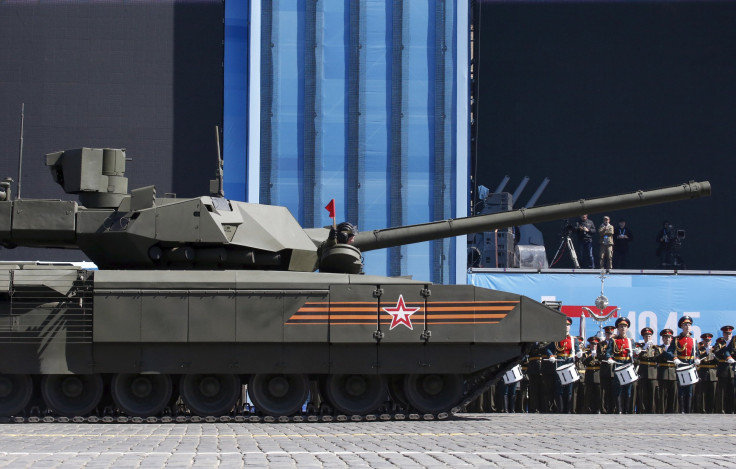As US Unveils AbramsX, Report Claims China's Latest Main Battle Tank Could Be Ready Soon
KEY POINTS
- China reportedly showed its latest MBT, although it was mostly covered
- No details were provided on the tank, but it is said to be "almost complete"
- This partial reveal comes as the U.S. unveiled its next-generation MBT this week
China continues to share glimpses of its military modernization efforts on state television. It showed footage of its latest main battle tank (MBT) Sunday, indicating that the fourth-generation vehicle with unmatched new capabilities could soon be ready for service in armored warfare, according to a report.
After showcasing its advanced Dongfeng series aircraft carrier killer nuclear missiles, China showed its latest MBT — mostly covered — with a caption that read, "The strongest on the surface in the future?" South China Morning Post (SCMP) reported Tuesday.
The SCMP report, which cited former military instructor Song Zhongping, noted that while no details were provided about the tank, the partial reveal suggested that the "development of China's most advanced main battle tank is almost complete."
The new tank is expected to have high mobility, stealth and strong strike capabilities and will be operated by two crew members instead of the standard three.
The report also claimed that at present, the most advanced Chinese main battle tanks are Type 99 and its upgraded version, the Type 99A. The Type 99 tanks entered service in 2001 with more than 1,200 of the model having been built in the past two decades. The Chinese military has deployed its Type 99A tanks at its high-altitude border region in the Karakoram mountain range bordering India.
Interestingly, the revelation of China's MBT comes as the U.S. unveiled its next-generation MBT, the AbramsX, this week. A report from Popular Mechanics described AbramsX as the most comprehensive and biggest design upgrade of the 40-year-old M1 Abrams tank. The AbramsX MBT will incorporate a number of modern features, including firepower, protection and mobility. Moreover, the hybrid conventional-electric propulsion system of AbramsX will enable 50% less fuel consumption along with silent mobility, as per SCMP.
Going by the said report, the key difference is that the latest MBT of China may only require two crew members to operate, while that of the U.S. will need at least three crew members.
Although AbramsX manufacturer General Dynamics indicated in its press release that the MBT will have AI-enabled features with autonomous capabilities, it did not provide further details about the actual crew size, Popular Mechanics pointed out.
Traditionally, the U.S. Abrams MBT requires four crew members — a commander, gunner, loader and driver. On the other hand, recent tanks, such as the German Leopard 2, Japanese Type 10 and South Korean K2, include an automatic loader, thus requiring only three crew members.
Popular Mechanics said the AbramsX features three crew hatches in the front of the vehicle, leading to the assumption that it will be the first Abrams to sport an automatic loader and an unmanned turret.
Meanwhile, Military Watch reported that crew reductions in China's fourth-generation tanks are expected to be achieved through greater levels of automation and greater reliance on artificial intelligence, which will allow one crew member to focus on driving while the other on using weapons.
The outlet also pointed out that previous reductions to the crew from four, the standard during the early period of the Cold War, was achieved by the Soviet Union in the 1960s when it introduced automatic loaders. However, a reduction of the crew to less than three members, which had long been speculated, is unlikely to be seen for some years on designs developed outside China, according to the report.
Russia officially unveiled its new-generation MBT — the T-14 Armata — during the Moscow Victory Day Parade in May 2015. The T-14 Armata, which requires three crew members, is equipped with digitalized equipment, an unmanned turret and an isolated armored capsule for the crew for the first time.
In recent years, China has invested heavily in advancing its military technology to develop more advanced weapons and equipment, also seeking to overhaul its military command structure with an aim to modernize its armed forces.
Beijing has also stepped up its weapons' exports to other developing countries, with the country emerging as a major supplier of weapon systems to countries in South and East Asia, Africa and Latin America.
Three of the world's top 10 arms companies are reportedly Chinese, and the country is among the world's top five weapons exporting nations. China is also one of the world's leading exporters of armed unmanned aerial vehicles (UAVs) to countries that include the United Arab Emirates and Saudi Arabia, according to SIPRI.

© Copyright IBTimes 2024. All rights reserved.






















